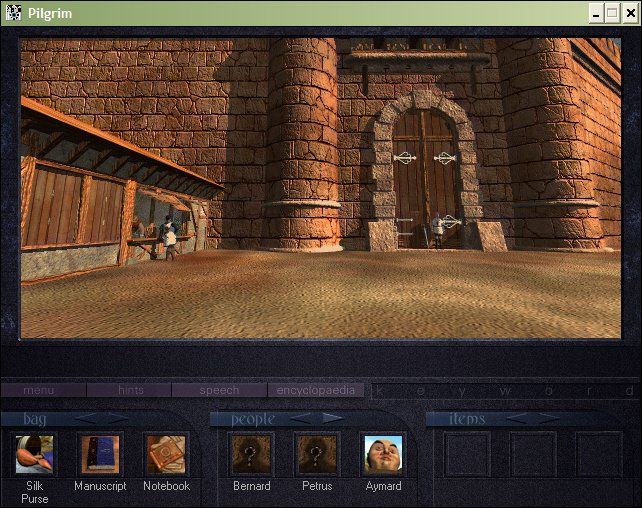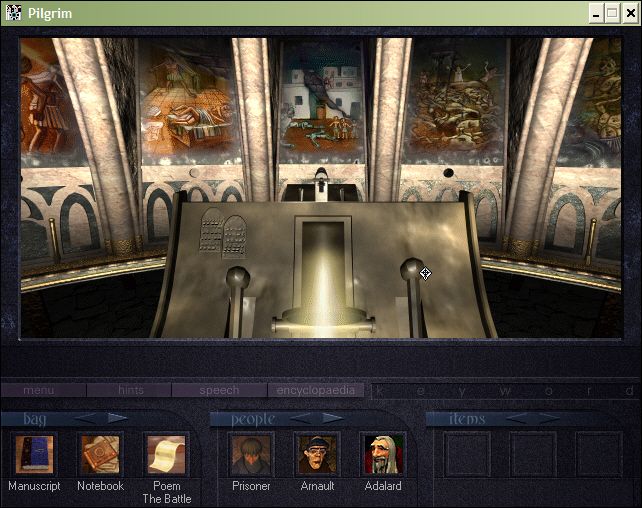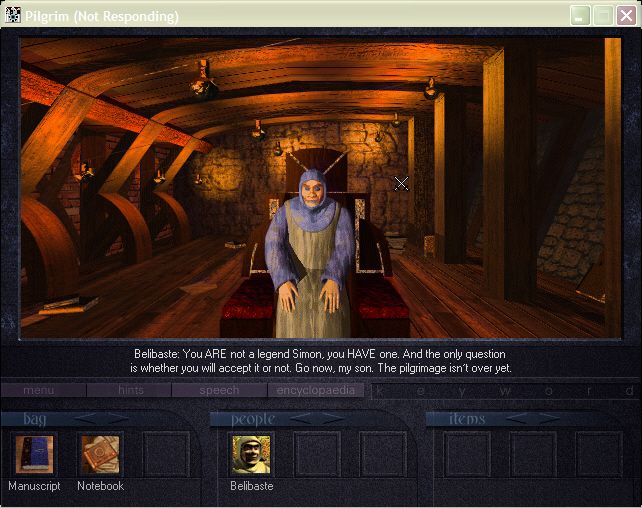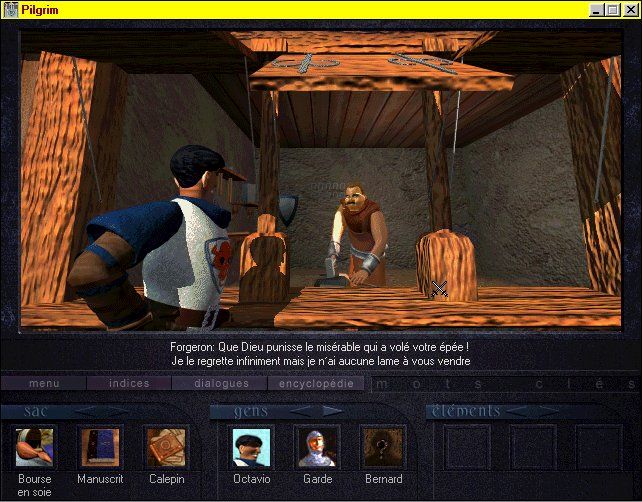Retro Replay Review
Gameplay
Pilgrim: Faith as a Weapon delivers a classic first-person, point-and-click adventure experience that will appeal to fans of the genre’s golden era. You guide Simon Lancroix through a richly detailed rendition of 1208 Southern France, clicking on hotspots to examine objects, pick up items and converse with NPCs. The unconventional interface integrates your inventory and dialogue topics into icon panels, encouraging you to think flexibly about when to use an object or bring up a name in conversation. This design can feel unfamiliar at first but deepens the sense of immersion once you master it.
(HEY YOU!! We hope you enjoy! We try not to run ads. So basically, this is a very expensive hobby running this site. Please consider joining us for updates, forums, and more. Network w/ us to make some cash or friends while retro gaming, and you can win some free retro games for posting. Okay, carry on 👍)
The game’s puzzles vary in style and complexity, ranging from mechanical conundrums—such as manipulating contraptions in a ruined fortress—to information-based challenges that require careful reading of in-game texts or hints dropped by supporting characters. The integrated hint system offers cryptic clues that never outright solve the puzzle for you, striking a balance between frustration and genuine accomplishment. Die-hard adventure fans will relish the mental workout, while casual players may find the occasional roadblock too opaque without consulting the detailed historical encyclopedia, which doubles as a reference guide.
Interaction with characters is at the heart of Pilgrim’s gameplay loop. Clicking on portraits of people Simon meets unlocks conversational topics and reveals backstory, clues or side quests. Angels, demons and everyday villagers all have distinct roles in Simon’s journey, and your choices in dialogue can alter the sequence of events or open alternative puzzle-solving paths. Although the linear storyline keeps you on a fairly guided track, the freedom to explore each village, gothic church or marketplace at your leisure adds a welcome layer of nonlinearity.
Graphics
Pilgrim’s visual style is rooted in pre-rendered 2D backgrounds complemented by occasional 3D elements, creating a painterly aesthetic that captures the medieval French countryside with surprising warmth. Each location—from sun-dappled village squares to shadowy monastic libraries—is meticulously illustrated, inviting players to linger over every scroll, alcove and tapestry. The attention to architectural detail not only grounds the narrative in its historical setting but also provides subtle visual cues for puzzle solutions.
Character portraits during dialogue phases are expressive and hand-drawn, presenting a range of emotions that breathe life into Simon and his companions. While the animation is minimal by modern standards, subtle touches—a flicker of a torch, the sway of a monk’s robes—suffice to maintain atmosphere. Color palettes shift seamlessly from the earthy tones of rural hamlets to the starker blues and grays of the gothic churches, reinforcing the tonal shifts in the story as you delve deeper into Simon’s secret mission.
On the audio front, a lilting medieval soundtrack underscores exploration, with gentle lute strains in marketplaces and organ chords in ecclesiastical settings. Sound effects—clanking metal, rustling scrolls, distant chanting—are restrained but effective, enhancing immersion without ever overwhelming the senses. While voice acting is absent, well-paced text and evocative musical cues carry the emotional weight, reminding players how much atmosphere can be conveyed through music and art alone.
Story
The narrative of Pilgrim: Faith as a Weapon draws inspiration from Paulo Coelho’s novel The Pilgrimage, weaving a tale of faith, danger and self-discovery. You assume the role of Simon Lancroix, summoned by his dying father to retrieve a cryptic manuscript hidden within a secret chamber. This simple premise soon unfolds into a tapestry of conspiracies involving the Church, mystical forces and the looming shadow of the Albigensian Crusade. Even though Simon initially stumbles through events in confusion, his gradual transformation into a determined seeker of truth feels rewarding and human.
Supporting characters—from benevolent abbots to enigmatic hermits—are crafted with enough nuance to avoid feeling like mere puzzle vending machines. Angels and demons appear both literally and allegorically, challenging Simon’s notions of faith and morality as he navigates threats from zealots and heretics alike. The game’s pacing allows for quiet moments of reflection in monastic gardens as well as tense stand-offs in fortress ruins, creating a narrative rhythm that keeps you engaged throughout the journey.
Perhaps most compelling is how Pilgrim blends historical context with allegorical elements. The in-game encyclopedia supplements the story with real-world facts about medieval society, theology and geography, offering players the option to deepen their understanding of the era. This layer of authenticity elevates the game beyond mere entertainment, making it a meaningful exploration of spirituality, loyalty and the price of hidden knowledge.
Overall Experience
Pilgrim: Faith as a Weapon stands out as a thoughtful, artful adventure that challenges players both intellectually and emotionally. Its unconventional interface may require a learning curve, but once mastered, it provides a satisfying toolset for unraveling intricate puzzles and engaging dialogues. The balance of vague hint prompts and comprehensive historical documentation ensures that you’re never completely lost, yet always rewarded for your own curiosity and perseverance.
Though the lack of voice acting may feel dated by today’s standards, the evocative soundtrack and richly painted backdrops more than compensate, often evoking a stronger sense of place than modern 3D engines. The story’s blend of faith-driven motivation, medieval intrigue and allegorical exploration makes Simon’s pilgrimage memorable long after you’ve solved the final puzzle.
For players seeking an adventure game that rewards careful observation, values historical authenticity and delivers a deeply human narrative, Pilgrim: Faith as a Weapon remains a hidden gem. Its emphasis on thoughtful interaction and atmospheric world-building offers a distinctive journey through medieval France—one that will resonate with anyone intrigued by faith, mystery and the timeless quest for meaning.
 Retro Replay Retro Replay gaming reviews, news, emulation, geek stuff and more!
Retro Replay Retro Replay gaming reviews, news, emulation, geek stuff and more!









Reviews
There are no reviews yet.